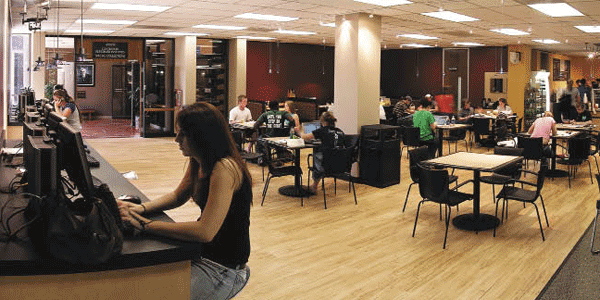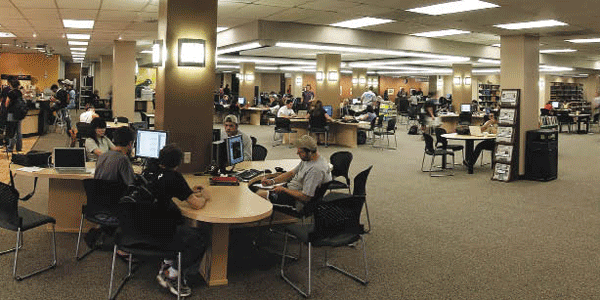
The learning commons in Abilene Christian University’s Brown Library
Photo Courtesy of Abilene Christian University


Movable furniture in Abilene Christian University’s learning commons allows students to reposition tables and chairs to suit their needs.
Photo Courtesy of Abilene Christian University
Collaboration on the Fly
In addition to classrooms designed for collaborative learning, the best campuses have engineered study areas and other nooks and crannies designed to engender spontaneous teamwork.
Many of these secondary collaborative spaces are in overtly public spots—the library or the student union. Others are offshoots of a larger collaborative learning space—a modern-day spin on the traditional notion of a breakout room. (For more on how libraries are transforming into new collaborative spaces, see “A Space to Collaborate,” CT November 2009; campustechnology.com/articles/2009/11/01/21st-century-classroom.aspx.)
At Harrisburg University of Science and Technology (PA), for instance, the school built a number of group-oriented study nooks in a high-rise building in downtown Harrisburg. These areas, formally dubbed “knowledge alcoves,” boast some of the same features as collaborative learning spaces elsewhere: comfortable furniture and an ample supply of A/C outlets.
Mel Schiavelli, Harrisburg’s president, says these spaces seat up to six people at a time, and are available on a first-come-first-served basis.
“So many collaborative learning environments only facilitate collaboration inside the classroom,” he says. “We wanted places where—when our students are out of class—they can still sit down and work with their teams.”
Different kinds of spaces at the circa-2009 Student Resource Center at the University of Phoenix facility in Washington, DC, have become popular for some of the same reasons.
Here, students have a number of options to work together: the learning team room, a glass-enclosed breakout room with flexible furniture that seats up to eight; the study room, which boasts pods for small group work; and the tutor bar, a Starbucks-like kiosk where students can walk up and get coffee—and help with their schoolwork.
Cyndie Shadow, the institution’s territory vice president for Maryland and Washington, DC, says these spaces provide the “foundation” for collaborations to occur organically.
“The truth is that some of the best collaborations occur outside of the classroom environment,” she says. “We thought that providing our students with the tools for these kinds of interactions when they step out of class would be just as valuable.”

To maximize flexibility and make sure students’ laptops won’t run out of battery life mid-
collaboration, the information commons at Louisiana State has one A/C outlet for every seat
Photo Courtesy of Louisiana State University

Acoustical issues were a key concern at RIT, where the University Services Center features a 1.5-story glass drum design. Sound baffles help keep noise amplification under control.
Photo Courtesy of Rochester Institute of Technology

